| Listing 1 - 10 of 36 | << page >> |
Sort by
|
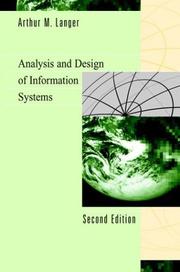
ISBN: 0387950389 1475734948 1475734921 Year: 2001 Publisher: New York (N.Y.) : Springer,
Abstract | Keywords | Export | Availability | Bookmark
 Loading...
Loading...Choose an application
- Reference Manager
- EndNote
- RefWorks (Direct export to RefWorks)
In any software design project, the analysis stage - documenting and designing technical requirements for the needs of users - is vital to the success of the project. This book provides a thorough introduction and survey to all aspects of analysis, including design of E-commerce systems, and how it fits into the software engineering process. The material is based on successful professional courses offered at Columbia University to a diverse audience of advanced students and professionals. An emphasis is placed on the stages of analysis and the presentation of many alternative modeling tools that an analyst can utilize. Particular attention is paid to interviewing, modeling tools, and approaches to building effective web-based E-commerce systems.
Information systems --- Computer software --- System analysis. --- Development. --- Software engineering. --- Application software. --- Software Engineering. --- Information Systems Applications (incl. Internet). --- Application computer programs --- Application computer software --- Applications software --- Apps (Computer software) --- Computer software engineering --- Engineering
Book
ISBN: 9783642011719 9783642011726 Year: 2009 Publisher: Heidelberg Springer
Abstract | Keywords | Export | Availability | Bookmark
 Loading...
Loading...Choose an application
- Reference Manager
- EndNote
- RefWorks (Direct export to RefWorks)
The Social Web (including services such as MySpace, Flickr, last.fm, and WordPress) has captured the attention of millions of users as well as billions of dollars in investment and acquisition. Social websites, evolving around the connections between people and their objects of interest, are encountering boundaries in the areas of information integration, dissemination, reuse, portability, searchability, automation and demanding tasks like querying. The Semantic Web is an ideal platform for interlinking and performing operations on diverse person- and object-related data available from the Social Web, and has produced a variety of approaches to overcome the boundaries being experienced in Social Web application areas. After a short overview of both the Social Web and the Semantic Web, Breslin et al. describe some popular social media and social networking applications, list their strengths and limitations, and describe some applications of Semantic Web technology to address their current shortcomings by enhancing them with semantics. Across these social websites, they demonstrate a twofold approach for interconnecting the islands that are social websites with semantic technologies, and for powering semantic applications with rich community-created content. They conclude with observations on how the application of Semantic Web technologies to the Social Web is leading towards the "Social Semantic Web" (sometimes also called "Web 3.0"), forming a network of interlinked and semantically-rich content and knowledge. The book is intended for computer science professionals, researchers, and graduates interested in understanding the technologies and research issues involved in applying Semantic Web technologies to social software. Practitioners and developers interested in applications such as blogs, social networks or wikis will also learn about methods for increasing the levels of automation in these forms of Web communication.
Computer architecture. Operating systems --- Computer Science. --- Information Systems Applications (incl.Internet). --- Information Storage and Retrieval. --- Artificial Intelligence (incl. Robotics). --- Computers and Society. --- Business Information Systems. --- Computer science. --- Information storage and retrieval systems. --- Information systems. --- Artificial intelligence. --- Management information systems. --- Informatique --- Systèmes d'information --- Intelligence artificielle --- Informatique de gestion --- Online social networks. --- Semantic Web. --- World Wide Web --- Social aspects. --- Information storage and retrieval systems
Book
ISBN: 9783642347511 9783642347528 Year: 2012 Publisher: New York, N.Y. Springer
Abstract | Keywords | Export | Availability | Bookmark
 Loading...
Loading...Choose an application
- Reference Manager
- EndNote
- RefWorks (Direct export to RefWorks)
This book constitutes the refereed proceedings of the 14th International Conference on Asia-Pacific Digital Libraries, ICADL 2012, held in Taipei, Taiwan, in November 2012. The 27 revised full papers, 17 revised short papers, and 13 poster papers were carefully reviewed and selected from 93 submissions. The papers are organized in topical sections on cultural heritage preservation, retrieval and browsing in digital libraries, biliometrics, metadata and cataloguing, mobile and cloud computing, human factors in digital library, presevation systems and algorithms, social media, digital library algorithms and systems, recommendation applications and social networks.
Library automation --- Computer architecture. Operating systems --- Computer Science. --- Information Storage and Retrieval. --- Database Management. --- Artificial Intelligence (incl. Robotics). --- User Interfaces and Human Computer Interaction. --- Information Systems Applications (incl. Internet). --- Document Preparation and Text Processing. --- Computer science. --- Database management. --- Information storage and retrieval systems. --- Artificial intelligence. --- Text processing (Computer science. --- Informatique --- Bases de données --- Systèmes d'information --- Intelligence artificielle --- Gestion
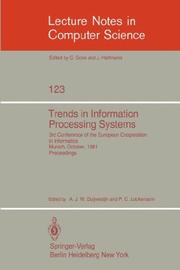
ISBN: 3540108858 3540387943 Year: 1981 Publisher: Berlin Springer
Abstract | Keywords | Export | Availability | Bookmark
 Loading...
Loading...Choose an application
- Reference Manager
- EndNote
- RefWorks (Direct export to RefWorks)
Computer. Automation --- 681.3*A0 --- 681.3*D20 --- 681.3*H24 --- General --- Computerwetenschap--?*D20 --- Systems: concurrency; distributed systems; query processing; transaction processing (Database management) --- 681.3*H24 Systems: concurrency; distributed systems; query processing; transaction processing (Database management) --- 681.3*A0 General --- Computer science. --- Computer Science. --- Information Systems Applications (incl. Internet). --- Informatics --- Science
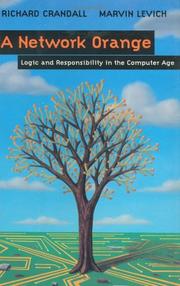
ISBN: 0387946470 1461274435 1461221722 Year: 1998 Publisher: New York (N.Y.) : Copernicus,
Abstract | Keywords | Export | Availability | Bookmark
 Loading...
Loading...Choose an application
- Reference Manager
- EndNote
- RefWorks (Direct export to RefWorks)
Computer technology has become a mirror of what we are and a screen on which we project both our hopes and our fears for the way the world is changing. Earlier in this century, particularly in the post-World War II era of unprecedented growth and prosperity, the social contract between citi zens and scientists/engineers was epitomized by the line Ronald Reagan promoted as spokesman for General Electric: "Progress is our most impor tant product. " In more recent decades, post-Chernobyl, post-Challenger, post-Bhopal, post-Microsoft, the social contract has undergone a transfor mation. More people are uncertain, fearful, and downright opposed to the notion that more technology guarantees a better life. What is a "better life"? Who benefits and who loses when new technologies change the way we live, work, learn, and play? Who has a say in the way technologies are designed and deployed? Where are we going, are we sure we want to go there, and who has the power to do anything about itt From the early days of the railroads, into the era of electrification, through the McLuhan age, much of the discourse about technology has been hype, utopianism, and what some historians have called "the rhetoric of the technological sublime. " We have discovered, however, that not all people benefit economically or politically from technological change.
Computer. Automation --- Philosophy and psychology of culture --- Computers and civilization. --- Computers --- Moral and ethical aspects. --- Application software. --- Multimedia information systems. --- Computer mathematics. --- Computers and Society. --- Information Systems Applications (incl. Internet). --- Multimedia Information Systems. --- Computational Mathematics and Numerical Analysis. --- Computer mathematics --- Electronic data processing --- Mathematics --- Computer-based multimedia information systems --- Multimedia computing --- Multimedia information systems --- Multimedia knowledge systems --- Information storage and retrieval systems --- Application computer programs --- Application computer software --- Applications software --- Apps (Computer software) --- Computer software --- Civilization and computers --- Civilization
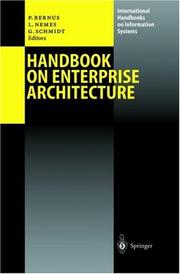
ISBN: 3540003436 3642055664 3540247440 Year: 2003 Publisher: Berlin : Springer,
Abstract | Keywords | Export | Availability | Bookmark
 Loading...
Loading...Choose an application
- Reference Manager
- EndNote
- RefWorks (Direct export to RefWorks)
This Handbook is about methods, tools and examples of how to architect an enterprise through considering all life cycle aspects of Enterprise Entities (such as individual enterprises, enterprise networks, virtual enterprises, projects and other complex systems including a mixture of automated and human processes). The book is based on ISO15704:2000, or the GERAM Framework (Generalised Enterprise Reference Architecture and Methodology) that generalises the requirements of Enterprise Reference Architectures. Various Architecture Frameworks (PERA, CIMOSA, Grai-GIM, Zachman, C4ISR/DoDAF) are shown in light of GERAM to allow a deeper understanding of their contributions and therefore their correct and knowledgeable use. The handbook addresses a wide variety of audience, and covers methods and tools necessary to design or redesign enterprises, as well as to structure the implementation into manageable projects. .
Business policy --- 681.3*J --- Computer applications --- Management information systems --- System design --- 681.3*J Computer applications --- Design, System --- Systems design --- Electronic data processing --- System analysis --- Architecture, Computer. --- Information technology. --- Business—Data processing. --- Application software. --- Management. --- Computer System Implementation. --- IT in Business. --- Information Systems Applications (incl. Internet). --- Administration --- Industrial relations --- Organization --- Application computer programs --- Application computer software --- Applications software --- Apps (Computer software) --- Computer software --- IT (Information technology) --- Technology --- Telematics --- Information superhighway --- Knowledge management --- Architecture, Computer
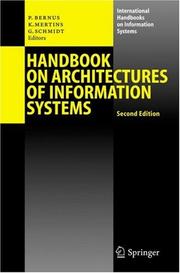
ISBN: 1281329355 9786611329358 3540266615 3540254722 9783540254720 Year: 2006 Publisher: Berlin Springer
Abstract | Keywords | Export | Availability | Bookmark
 Loading...
Loading...Choose an application
- Reference Manager
- EndNote
- RefWorks (Direct export to RefWorks)
This book is the first volume of a running series under the title International Handbooks on Information Systems. The series is edited by Peter Bernus, Jacek Blazewicz, Günter Schmidt and Mike Shaw. One objective is to give state of the art surveys on selected topics of information systems theory and applications. To this end, a distinguished international group of academics and practitioners are invited to provide a reference source not only for problem solvers in business, industry, and government but also for professional researchers and graduate students. It seemed appropriate to start the series with a volume covering some basic aspects about information systems. The focus of the first volume is therefore architectures. It was decided to have a balanced number of contributions from academia and practitioners. The structure of the material follows a differentiation between modelling languages, tools and methodologies. These are collected into separate parts, allowing the reader of the handbook a better comparison of the contributions. Information systems are a major component of the entire enterprise and the reader will notice that many contributions could just as easily have been included in another volume of the series which is on enterprise integration. Conversely, some traditionally information systems topics, as organizational analysis and strategic change management methods, will be treated in more depth in the Handbook on Enterprise Integration. The two volumes will complement each other.
Computer architecture. --- System design. --- Information technology. --- IT (Information technology) --- Technology --- Telematics --- Information superhighway --- Knowledge management --- Design, System --- Systems design --- Electronic data processing --- System analysis --- Architecture, Computer --- Information systems --- Computer architecture. Operating systems --- Computer network architectures. --- Information Systems. --- Computer System Implementation. --- IT in Business. --- Information Systems Applications (incl. Internet). --- Management of Computing and Information Systems. --- Architectures, Computer network --- Network architectures, Computer --- Computer architecture --- Architecture, Computer. --- Business—Data processing. --- Application software. --- Management information systems. --- Computer science. --- Informatics --- Science --- Computer-based information systems --- EIS (Information systems) --- Executive information systems --- MIS (Information systems) --- Sociotechnical systems --- Information resources management --- Management --- Application computer programs --- Application computer software --- Applications software --- Apps (Computer software) --- Computer software --- Communication systems
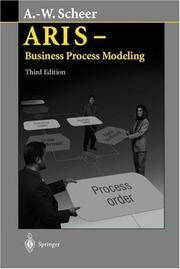
ISBN: 3540658351 364263009X 3642571085 9783540658351 Year: 2000 Publisher: Berlin ; New York : Springer,
Abstract | Keywords | Export | Availability | Bookmark
 Loading...
Loading...Choose an application
- Reference Manager
- EndNote
- RefWorks (Direct export to RefWorks)
ARIS (Architecture of Integrated Information Systems) is a unique and internationally renowned method for optimizing business processes and implementing application systems.This book describes in detail how ARIS methods model and realize business processes by means of UML (Unified Modeling Language), leading to an information model that is the keystone for a systematic and intelligent method of developing application systems.Multiple real-world examples - including knowledge management, implementation of workflow systems and standard software solutions (SAP R/3 in particular) - address the deployment of ARIS methods.
procesmanagement (economie) --- Artificial intelligence. Robotics. Simulation. Graphics --- ICT (informatie- en communicatietechnieken) --- Business policy --- systeemontwikkeling (informatica) --- Business --- Computer network architectures. --- Information technology. --- System design. --- Data processing. --- Business—Data processing. --- Application software. --- Industrial engineering. --- Production engineering. --- IT in Business. --- Information Systems Applications (incl. Internet). --- Industrial and Production Engineering. --- Manufacturing engineering --- Process engineering --- Industrial engineering --- Mechanical engineering --- Management engineering --- Simplification in industry --- Engineering --- Value analysis (Cost control) --- Application computer programs --- Application computer software --- Applications software --- Apps (Computer software) --- Computer software --- IT (Information technology) --- Technology --- Telematics --- Information superhighway --- Knowledge management --- Business - Data processing --- System Design --- Computer network architectures --- Information technology
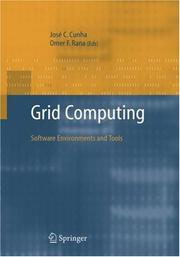
ISBN: 1846283396 1852339985 Year: 2006 Publisher: London Springer
Abstract | Keywords | Export | Availability | Bookmark
 Loading...
Loading...Choose an application
- Reference Manager
- EndNote
- RefWorks (Direct export to RefWorks)
With the emergence of regional, national and global programmes to establish Grid computing infrastructure, it is important to be able to utilise this infrastructure effectively. Specialist software is therefore necessary to enable the deployment of applications over such Grid infrastructure, and to help software developers construct suitable components. The uptake of Grid computing technologies will be restricted by the availability of suitable methodologies and tools. The aim of this book is to identify exemplary software engineering techniques for Grid environments, along with specialist tools that encapsulate such techniques. Case studies that illustrate their use are also discussed. The book provides: • Discussion of software engineering and modelling tools for the Grid • Analysis of issues inherent in enabling distributed computing across the Grid • Consideration of the software engineering support necessary for managing Grid applications • Proposal of a posited software engineering lifecycle to support application development for Grid Environments (along with associated tools). • Identification of novel concepts, methods and tools within Grid computing which can be put to work in the context of existing experiments and application case studies.
Computer science. --- Computer communication systems. --- Software engineering. --- Computer Science. --- Software Engineering. --- Computer Communication Networks. --- Information Systems Applications (incl. Internet). --- Computational grids (Computer systems) --- Grid computing --- Grids, Computational (Computer systems) --- Computer systems --- Cyberinfrastructure --- Information Technology --- Software Engineering --- Computer architecture. Operating systems --- Computer software engineering --- Engineering --- Application software. --- Application computer programs --- Application computer software --- Applications software --- Apps (Computer software) --- Computer software --- Communication systems, Computer --- Computer communication systems --- Data networks, Computer --- ECNs (Electronic communication networks) --- Electronic communication networks --- Networks, Computer --- Teleprocessing networks --- Data transmission systems --- Digital communications --- Electronic systems --- Information networks --- Telecommunication --- Electronic data processing --- Network computers --- Distributed processing
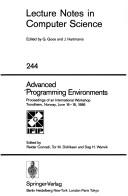
ISBN: 3540171894 0387171894 3540473475 Year: 1986 Volume: 244 Publisher: Berlin Heidelberg New York Springer
Abstract | Keywords | Export | Availability | Bookmark
 Loading...
Loading...Choose an application
- Reference Manager
- EndNote
- RefWorks (Direct export to RefWorks)
681.3*D26 --- 681.3*K63 --- 681.3*K63 Software management: software development software selection software maintenance --- Software management: software development software selection software maintenance --- 681.3*D26 Programming environments: interactive (Software engineering) --- Programming environments: interactive (Software engineering) --- Programming --- Computer. Automation --- 681.3*K63 Software management: software development; software selection; software maintenance --- Software management: software development; software selection; software maintenance --- Computer programming --- Programmation (Informatique) --- Congresses --- Congrès --- Software engineering. --- Computer science. --- Software Engineering. --- Programming Techniques. --- Information Systems Applications (incl. Internet). --- Informatics --- Science --- Computer software engineering --- Engineering --- Electronic digital computers. --- Programming-congresses
| Listing 1 - 10 of 36 | << page >> |
Sort by
|

 Search
Search Feedback
Feedback About UniCat
About UniCat  Help
Help News
News